Tesla Motors Inc. (NASDAQ:TSLA) of Palo Alto, CA, is a leading innovator in the fields of electric vehicles (EVs) and energy storage systems which has been having a very successful run in the past few weeks. The company’s soon to be released Model S P85D electric sedan just earned the highest Consumer Reports rating for a vehicle, earning 103 points on a 100-point scale and essentially requiring the independent consumer product review publication to reformulate its rating system. Although that car is likely to retail at prices over $100,000, Tesla CEO Elon Musk recently announced the development of a low-end electric sedan that will cost around $35,000. These electric vehicles are rated to travel about 200 miles on a full charge although a duo from Denmark claimed that they took a Tesla Model S for a drive of more than 450 miles on one charge.
Tesla’s lithium ion battery technologies are also gearing up to have a huge effect on energy markets outside of vehicle. The company’s Powerwall home energy storage systems might run into competition from sometimes-partner Panasonic Corporation (OTCMKTS:PCRFY) in Europe, a continent where both companies may market home battery products. In America, Tesla has been leading the way in the nascent energy storage industry, a sector which saw a six-fold increase in deployment in the second quarter of 2015 alone.
At IPWatchdog we’ve been very critical about some Elon Musk doublespeak on the subject of patents. Last June, he offered to open source all of Tesla’s patented technologies in a blog post that equated earning a patent to buying a ticket to a lawsuit. Musk maintains that he has avoided patents since leaving a business venture in 1999 but we’ve been pointing out how companies in which he holds a large interest have been acquiring IP and filing new patent applications themselves. In fact, as the IP portfolio analysis tools from Innography show us, Tesla has earned 27 patents thus far in 2015, making it pretty clear that Elon Musk is doing an awful job of avoiding patents, which really has to make you wonder what is behind his anti-patent rhetoric. Certainly his hatred of patents doesn’t extend to the innovations of his own company, which at the very least means Musk is engaging in a “do as I say not as I do” approach to patents.
Regardless of Musk’s patent hypocrisy, Tesla will likely get its first test on how well it can stand copycat products from American and Chinese companies in the market with a number of rivals from both countries looking to unveil electric vehicles in the next few years. Maybe Musk’s view of the patent system will change as Tesla becomes challenged in the marketplace. Only time will tell.
Tesla’s Issued Patents: Environmental Controls for Battery Packs and Aerodynamic Door Handles
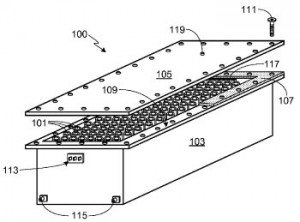 Controlling the environmental conditions within which a battery operates is of great importance to a longer service life, as is reflected within U.S. Patent No. 9040184, titled Battery Pack Dehumidifier with Active Reactivation System. The battery pack dehumidifier system disclosed here includes a battery pack enclosure holding a plurality of batteries and a dehumidifier comprised of an enclosure holding a desiccant, an air passageway coupling the desiccant enclosure to the battery pack enclosure which allows the desiccant to absorb water vapor, a controller that estimates when the desiccant loses absorption/adsorption efficacy, a heater assembly that heats the desiccant to release water vapor and reactivate it and a second air passageway coupling the desiccant to a volume of air outside of the battery pack to release moisture. This innovation intends to provide a maintenance-free humidity control for EV battery packs that serve throughout the life of the vehicle. Ensuring a proper level of temperature in a battery is the focal point of U.S. Patent No. 8968949, titled Method of Withdrawing Heat from a Battery Pack. This patent claims a method of withdrawing heat by coupling electrically and thermally conductive tabs of each battery cell to the surface of a common current collector plate, conducting electricity and thermal energy through those conductive tabs, coupling a second surface of the common current collector plate to a first surface of a thermal interface layer, coupling a second surface of the thermal interface layer to a temperature control panel and transferring thermal energy from the conductive tabs towards the temperature control panel. Excessive battery heating during charging and discharging can negatively impact battery life, which this innovation seeks to improve.
Controlling the environmental conditions within which a battery operates is of great importance to a longer service life, as is reflected within U.S. Patent No. 9040184, titled Battery Pack Dehumidifier with Active Reactivation System. The battery pack dehumidifier system disclosed here includes a battery pack enclosure holding a plurality of batteries and a dehumidifier comprised of an enclosure holding a desiccant, an air passageway coupling the desiccant enclosure to the battery pack enclosure which allows the desiccant to absorb water vapor, a controller that estimates when the desiccant loses absorption/adsorption efficacy, a heater assembly that heats the desiccant to release water vapor and reactivate it and a second air passageway coupling the desiccant to a volume of air outside of the battery pack to release moisture. This innovation intends to provide a maintenance-free humidity control for EV battery packs that serve throughout the life of the vehicle. Ensuring a proper level of temperature in a battery is the focal point of U.S. Patent No. 8968949, titled Method of Withdrawing Heat from a Battery Pack. This patent claims a method of withdrawing heat by coupling electrically and thermally conductive tabs of each battery cell to the surface of a common current collector plate, conducting electricity and thermal energy through those conductive tabs, coupling a second surface of the common current collector plate to a first surface of a thermal interface layer, coupling a second surface of the thermal interface layer to a temperature control panel and transferring thermal energy from the conductive tabs towards the temperature control panel. Excessive battery heating during charging and discharging can negatively impact battery life, which this innovation seeks to improve.
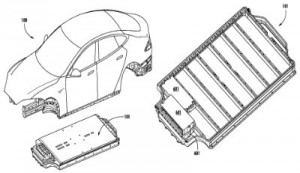 We noted an interesting technology that uses a battery pack’s configuration to improve rider safety in some collisions, discussed within U.S. Patent No. 9045030, titled System for Absorbing and Distributing Side Impact Energy Utilizing an Integrated Battery Pack. The patent protects an energy absorbing and distributing side impact system for a vehicle which includes a battery pack enclosure with side and cross members mounted between a vehicle’s front and rear suspensions; the cross members segregate the battery pack into sections, each of which hold an individual battery module. The cross members used in this battery pack configuration help to absorb and distribute at least a portion of a side impact.
We noted an interesting technology that uses a battery pack’s configuration to improve rider safety in some collisions, discussed within U.S. Patent No. 9045030, titled System for Absorbing and Distributing Side Impact Energy Utilizing an Integrated Battery Pack. The patent protects an energy absorbing and distributing side impact system for a vehicle which includes a battery pack enclosure with side and cross members mounted between a vehicle’s front and rear suspensions; the cross members segregate the battery pack into sections, each of which hold an individual battery module. The cross members used in this battery pack configuration help to absorb and distribute at least a portion of a side impact.
Luxury interior touches such as a touch-screen interactive display are also the focus of Tesla R&D to judge by U.S. Patent No. 9079498, issued under the title Morphing Vehicle User Interface. The method of operating a vehicle user interface protected here involves providing a touch-screen display within the vehicle, displaying a vehicle subsystem interface on the display and displaying a plurality of touch-screen function controllers which correspond to vehicle subsystems and interactive to display an active input region. This innovation seeks to provide vehicle owners with a touch-screen display that has a high degree of customizability.
No area of car design is too slight to be improved aerodynamically as readers can see within U.S. Patent No. 9103143, titled Door Handle Apparatus for Vehicles. The door handle assembly disclosed here includes a door handle formed from a planar handle member, a motor and a swing arm with upper and lower dual fork portions which are rotatably coupled to a handle base member; the s wing arm is extended and retracted by the motor. The patent points out how door handles are an area of vehicle design which are not
wing arm is extended and retracted by the motor. The patent points out how door handles are an area of vehicle design which are not
optimized to reduce aerodynamic drag. An improved seating assembly for Tesla’s EVs are at the center of U.S. Patent No. 8973965, which is titled Folding and Stowing Rear-Facing Vehicle Seat. This patent protects a rear-facing seat for a vehicle that includes a seat portion connected to the vehicle by a hinge so that the seat can assume stowed and unstowed positions and a back portion connected to the seat which assumes up and down positions by engaging with either a first or second striker. This innovation was pursued to improve cargo space within EVs.
Patent Applications of Note: From Fast Charging Systems to More Vehicle Door Handle Innovation
Fast charging techniques for EVs were featured in a couple of recently published patent applications filed by Tesla. U.S. Patent Application No. 20150077057, titled Low Temperature Fast Charge, would protect a method of determining whether a fast charging process transferring energy of rates of at least 1C is possible for a battery pack, charging the battery pack using the process if possible and charging the battery pack at rates of less than 1C if the fast charging process is not possible. This innovation provides a method by which fast charging techniques can be applied without risking damage to the battery. Fast charging of lithium ion battery packs is also 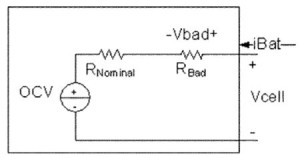 discussed within U.S. Patent Application No. 20150171644, titled Fast Charging of Battery Using Adjustable Voltage Control. The method for charging a lithium ion cell disclosed here involves applying a constant first stage charging current greater than 1C until a first stage charging voltage is about equal to a first charge complete voltage and applying multiple second stage charging currents to the cell at different current levels after which a third stage charging current equal to the complete voltage of the second stage currents is applied. This innovation also seeks to reduce EV charging times without negatively impacting battery cycle life.
discussed within U.S. Patent Application No. 20150171644, titled Fast Charging of Battery Using Adjustable Voltage Control. The method for charging a lithium ion cell disclosed here involves applying a constant first stage charging current greater than 1C until a first stage charging voltage is about equal to a first charge complete voltage and applying multiple second stage charging currents to the cell at different current levels after which a third stage charging current equal to the complete voltage of the second stage currents is applied. This innovation also seeks to reduce EV charging times without negatively impacting battery cycle life.
Tesla is also concerned with charging batteries safely as well as quickly, as readers can see within U.S. Patent Application No. 20150039255, entitled Methodology for Charging Batteries Safely. The fault-detection apparatus for a charging system that charges a collection of interconnected battery cells claimed here comprises a data-acquisition system for receiving a set of temperature data parameters measured during a charge cycle, a monitoring system evaluating data parameters to identify a set of anomalous conditions and a controller comparing a set of anomalous conditions against a set of predetermined profiles indicative of an internal short within a cell. This technology for identifying the presence of a short circuit in a battery pack is intended to prevent hazardous operation of the  battery pack. Techniques for cooling a charging unit while it charges an EV are detailed within U.S. Patent Application No. 20150217654, titled Cooling of Charging Cable. This would protect a charging system for an EV that includes a power supply, a charging conductor cable connected at one end to a power supply and having a cooling conduit and a connector attached to the cable’s second end. The cooling conduit is configured to hold a cooling fluid that helps to dissipate the heat created when charging an electric vehicle at high continuous currents.
battery pack. Techniques for cooling a charging unit while it charges an EV are detailed within U.S. Patent Application No. 20150217654, titled Cooling of Charging Cable. This would protect a charging system for an EV that includes a power supply, a charging conductor cable connected at one end to a power supply and having a cooling conduit and a connector attached to the cable’s second end. The cooling conduit is configured to hold a cooling fluid that helps to dissipate the heat created when charging an electric vehicle at high continuous currents.
Lithium ion battery cell caps which provide cathode terminals and other electronic components are at the center of U.S. Patent Application No. 20150147600, which is titled Cap for Electrochemical Cell. The electrochemical cell that would be protected here includes a cell can, an electrolyte and a cap closing one end of the cell can, the cap having a substantially flat member, a separation portion and a diaphragm covering the separation portion on the substantially flat member. This cell cap configuration enables battery cell manufacturing processes which use fewer parts, making fabrication both faster and cheaper.
It doesn’t appear that Tesla is done with door handle innovation by the looks of U.S. Patent Application No. 20150035296, titled Controller Apparatus and Sensors for a Vehicle Door Handle. This patent application discloses a door handle assembly having a door handle formed from a planar handle member with two post portions, a swing arm coupled to distal ends of both post portions and rotatably attached to a shaft mounted to an inner surface of a vehicle door, an extension force sensor attached to the vehicle door’s inner surface which generates a signal in response to an extension force, a retraction force sensor attached to a lower portion of the swing arm which generates a signal in response to a retraction force and a handle controller that controls operation of the door handle assembly by processing the retraction and extension force signals. This sensor system is designed to respond to a person’s manual operation of a door handle so that the handle automatically extends or retracts as is needed.
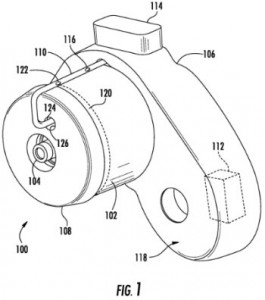 Finally, we thought we’d share with our readers the active cooling system technology discussed within U.S. Patent Application No. 20150222162, entitled Pressurized and Gravity-Fed Liquid Cooling of Electric Motor. The liquid cooling system for an electric motor disclosed here includes a pump for liquid to cool the motor, a heat exchanger removing heat from the liquid, a manifold that receives the liquid under
Finally, we thought we’d share with our readers the active cooling system technology discussed within U.S. Patent Application No. 20150222162, entitled Pressurized and Gravity-Fed Liquid Cooling of Electric Motor. The liquid cooling system for an electric motor disclosed here includes a pump for liquid to cool the motor, a heat exchanger removing heat from the liquid, a manifold that receives the liquid under
pressure and extends above a stator of the motor and a first tray above first end turns of the stator onto which a liquid jet is directed from the manifold. The tray also has an opening to perform gravity-fed liquid distribution onto the first end turns. This invention provides a cooling system for a stator which includes complex components so that it doesn’t operate at unsafe temperature levels.

![[IPWatchdog Logo]](https://ipwatchdog.com/wp-content/themes/IPWatchdog%20-%202023/assets/images/temp/logo-small@2x.png)

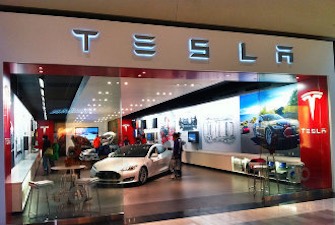
![[[Advertisement]]](https://ipwatchdog.com/wp-content/uploads/2023/01/2021-Patent-Practice-on-Demand-1.png)
![[Advertisement]](https://ipwatchdog.com/wp-content/uploads/2024/04/Patent-Litigation-Masters-2024-sidebar-early-bird-ends-Apr-21-last-chance-700x500-1.jpg)

![[Advertisement]](https://ipwatchdog.com/wp-content/uploads/2021/12/WEBINAR-336-x-280-px.png)
![[Advertisement]](https://ipwatchdog.com/wp-content/uploads/2021/12/2021-Patent-Practice-on-Demand-recorded-Feb-2021-336-x-280.jpg)
![[Advertisement]](https://ipwatchdog.com/wp-content/uploads/2021/12/Ad-4-The-Invent-Patent-System™.png)







Join the Discussion
17 comments so far.
Benny
September 13, 2015 09:17 amGene,
you state that ” all they would have to do is publicly disclose the technology and then no one else could ever obtain a patent”.
In a perfect world, yes, but given the poor track record of the USPTO in identifying prior art, that should read ” …and then no one else could defend the patent they obtained in post-grant review”.
Alexander
September 12, 2015 01:51 pmGene,
When you say “if the client has no desire to enforce a patent then the pursuit of the patent … is a waste of resources” you appear to deny the value of a patent as a defensive instrument. IBM’s practices does not nullify the value of defensive patenting, or even show that IBM doesn’t engage in defensive patenting.
Musk is an obnoxious self-aggrandizer, and surely wouldn’t hesitate to enforce his patents if he felt it was in his best interest. But defensive patenting exists, and his position is at least possibly consistent.
Gene Quinn
September 11, 2015 10:11 pmAlexander-
Why would I advise a client to waste money? If the client has no desire to enforce a patent then the pursuit of the patent, including the cost, is a waste of resources.
You should look into how IBM handles this issue. It is well known in the industry that IBM files a lot of patent applications, but they also publish a lot of information relative to innovations that they do not seek to patent. The IBM publication program is well known and widespread. IBM has made their publications available to the USPTO.
So now you are confronted with an inconvenient truth. Elon Musk is lying to you. If he believes patents are useless and will let everyone use them then he is engaging in abuse of resources to obtain them. So either Musk is misusing corporate funds or he is a hypocrite. If you open your eyes and inform yourself on basic patent law and practice you will see clearly that Musk is a hypocrite.
-Gene
Mario
September 11, 2015 09:22 pmGene,
I agree with you. I am pretty sure you know a little bit on how the patent law in the USA works, being as you are an instructor of the patent exam course for prospective patent agents / patent attorneys.
I don’t think it is fair for you to be arguing with Elon Musk “fans” who read a little about patent law on Wikipedia and think they know what they are talking about.
Keep up the great reporting.
– mario
Alexander
September 11, 2015 05:37 pmGene,
Are you saying that if you had an applicant with a huge budget who wanted to “release” an invention, you would advise them to only disclose the invention? It seems to me the much stronger position would be to file and prosecute vigorously to get the best patent possible. That would potentially enable countersuit if the competition’s patent was ever issued.
Gene Quinn
September 11, 2015 10:46 amAnon-
Very true. Those who don’t understand just how much of a hypocrite Elon Musk is with respect to patents don’t know the first thing about the patent system. Musk is misleading all his fans and they are so completely clueless that they have absolutely no idea.
All I can do is tell the truth. That those with a man crush on Elon Musk ignore the truth is a problem for them. In the meantime, expect more truthful and 100% accurate ‘Elon Musk is a Hypocrite’ articles. Sunlight is the best disinfectant even if there are those who continue to firmly plan their head in the sand.
-Gene
Anon
September 10, 2015 11:28 pmThere is a certain “cult of personality” that envelopes Mr. Musk.
Those that are swept up in that fervor, are not the ones that can likely discuss patent policy, patent law, or the simple marketing tactics being used by Mr. Musk.
Gene Quinn
September 10, 2015 03:33 pmJohnny-
You ask: “How can you tell people to use your patents if you don’t file them?”
You obviously can’t tell people to use a patent that doesn’t exist. Of course, Musk could save a whole lot of money and just tell people they can use Tesla technology if he never plans on enforcing patent rights. Either he is lying or he is misusing corporate funds.
-Gene
Gene Quinn
September 10, 2015 03:32 pmBen-
Musk never flatly said he would never prohibit anyone from using his patents. You are misinformed.
Musk said that Tesla will not initiate patent lawsuits against anyone who, in good faith, wants to Tesla technology. Musk is the arbiter of what it means to be “in good faith,” so he has clearly left open the possibility that he will sue for patent infringement.
-Gene
Gene Quinn
September 10, 2015 03:30 pmWeapon-
You are WRONG. I don’t know how else I can say it. You can say you and others have addressed this point on many occasions, but all that means is that you have addressed it incorrectly and gotten it wrong.
All you have to do is disclose the reference and no one else will be able to obtain a patent, period. That is what it means to be first to file in the U.S. Anyone who tells you otherwise is not being honest.
Further, if Musk doesn’t like patents and he is concerned that his disclosure wouldn’t be prior art then why not just file for the patent application and then abandoned the applications once they publish, which you can do. He doesn’t do that because he wants the patents.
You Musk fan boys are really so intellectually dishonest.
Bernard
September 10, 2015 03:25 pmGene,
Perhaps you need to learn how the patent system works?
Weapon
September 10, 2015 03:16 pmGene, that is incorrect. This has been addressed on many occasions, frankly put, US law has no way of making something public domain. Which is why Creative Commons created the CC0 licensing. To try to create as legally possible a public domain equivalent. (of course this is for copyright works but same concept applies to patents)
Musk has also made it clear that they will make their patents open to all those who use them in “good faith”. Which means if a company uses Tesla’s patents, but then patents their own stuff and uses those patents to hinder the industry, Tesla might use theirs, because that would not qualify for “good faith”.
So if anything the patents are published more like a ShareAlike license.
Just because Musk doesn’t like patents doesn’t mean he is immune from being a target of the legal system.
Ben
September 10, 2015 02:38 pmYou do understand that Musk never said he wouldn’t file for patents, correct? He just said that they would never prohibit anyone else from using of them. If Tesla didn’t file for patents then any other company could file patents for the same thing and accuse Tesla of using their technology. Even if Tesla was already using them they would then need to provide proof they’d already been using them, which given the number of patents they file for would be an enormous headache and waste of time. The basis of your article is misinformed here, might be a good time to fact check your article 😉
Johnny
September 10, 2015 01:48 pmHow can you tell people to use your patents if you don’t file them? In that case, you can use all my patents too because I have none. Also, Elon doesn’t care about people using his patents but he cares about other people taking him to court for using theirs. He also doesn’t want to have a team to watch every patent filed to catch patents on technology he already uses.
Gene Quinn
September 10, 2015 11:59 amAlex-
You are incorrect. The U.S. is a first to file country, but that requires that you file before use. If Tesla wanted to prevent others from obtaining patents all they would have to do is publicly disclose the technology and then no one else could ever obtain a patent. That is why Musk is either a liar or so hopelessly misinformed about patents that he doesn’t have even the most basic knowledge appropriate to comment on the subject. Given how successful Musk is it stretches the imagination to suggest that he is ignorant about U.S. patent laws, which has to mean he is lying.
-Gene
Alex Linebrink
September 10, 2015 11:19 amCorrect me if I’m wrong, but doesn’t the US now operate under a first-to-file patent system? Meaning the first person to file a patent gets awarded it… not necessarily the first to use the technology? And doesn’t this system only award patents to one party at a time?
In that case, Tesla has no choice but to patent innovations if they want to keep them open and available for all to use. Basically, they have to patent something in order to open source it. To not patent an innovation would be allowing someone else to patent it first, and that person could then block others from using it.
That doesn’t sound like double-speak to me. That actually sounds incredibly consistent with their mission of making sure the latest technology is available for everyone to use. They could be rushing to get as many patents as possible simply in order to open source them.
Enyo
September 10, 2015 10:28 amThat is a very cheap trick in order to make your posts interesting.
He NEVER said that they will not have patents, actually exactly the opposite.
He DID say that they will keep patenting, so that nobody else will patent it and forbid them to use their own technology. AND he said that he will not sue or prosecute anybody that uses their patents.
So you basically summarized the issued patents. Well-done.